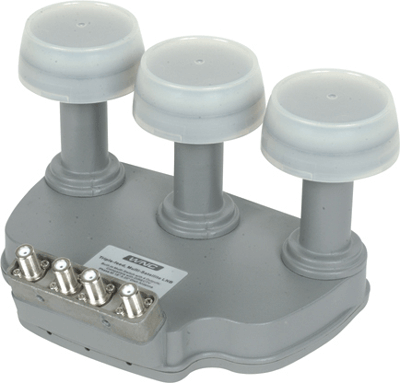Way back in the 1990s… it looked like it wouldn’t matter whose satellite service you used, you would be able to use the same dish. This was actually true (at least for the dish… you needed a different receiver for your specific service) but but the mid-2000s it stopped being true. Today there’s really nothing common between HD dishes for DISH, DIRECTV, or any of the services used all over the world. It’s become a bit of a confusing mess for people who switch carriers… why is that?
Yes, Europe does it.
You can buy a dish in Great Britain and use it in Italy. In fact that same dish can be used practically anywhere in the world, except the USA. Well, sort of. Many European countries have “Freeview” satellite service. Instead of using a robust network of local broadcasts like we do here, a lot of channel capacity is provided by satellite. This is an easier way to distribute national channels, although it is more expensive to get that satellite working. In those other countries, television service is provided through a tax you pay. This makes it possible to use the best technology, not just the most cost-effective one.
In some countries, premium satellite services do exist and you use special equipment for it, just like in the USA.
Multiple satellites
In order to bring you hundreds of high definition channels, it takes multiple satellites in multiple locations. In order to be able to use one dish to point at all the locations you need, the dish must be specifically designed. You’ll notice that the feed horns (the white plastic parts) on some LNBs are evenly spaced while on others they’re organized in clumps. That’s because of the spacing required between satellites.
Different broadcast frequencies
Direct-to-home satellite reception all over the world uses the same set of frequencies on what’s commonly known as the Ku band. Every provider, that is, except DIRECTV who uses the Ka band for its high-definition signals. DIRECTV paid dearly for exclusive use of the Ka band frequencies in North America so that they could have virtually limitless possibilities to expand service and add channels. It’s worked out well for them so far.
Location, location, location
DISH uses two fleets of satellites, one at each edge of the country. DIRECTV uses only one fleet but some markets also get satellite signals from a satellite over San Diego California. Because there are several different configurations, it would be cost-prohibitive to create one dish that served all of them. Since most people have a single provider in a single location, it makes more sense to make LNBs for each need.
The real bottom line is cost
It doesn’t make sense for DIRECTV, Sky, DISH, and other satellite services around the world to cooperate. They won’t create a universal HD LNB because there isn’t any benefit to it. Each provider manufactures its own LNBs for its own service. They can do that cheaply because there’s nothing in an LNB that isn’t needed for that specific service. The global market for “universal HD LNB” equipment is probably not more than a few thousand people. There are millions of people served by satellite services that offer single-provider LNBs. It’s hard to argue with the almighty dollar.
Get the best equipment at Solid Signal
You’ll find everything you need for your home, RV, truck fleet, or vessel when you shop the great selection at Solid Signal. If you need help choosing, call the experts now at 888-233-7563!





